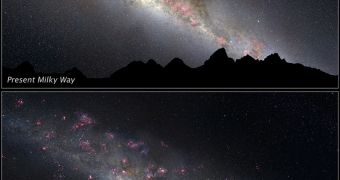A team of astronomers recently used data from the NASA Hubble Space Telescope to produce an impressive image of the Milky Way in its formative years. The photo shows how the first stars and clusters formed in the galaxy, before it reached the impressive size it boasts today. Our galaxy now has a diameter of roughly 120,000 light-years.
Researchers used the American space agency's flagship telescope to conduct deep-sky surveys of 400 galaxies closely resembling our own. The evolutionary history of these objects was traced back more than 11 billion years, to a time when the Universe was just a fraction of its current age.
The work revealed that the Milky Way began as a gas-rich object that contained numerous young, blue stars, as well as vast volumes of gas. Over eons, intense star formation processes occurring in various nebulae led to the majestic pinwheel appearance the galaxy boasts today.
Over the course of its history, the galaxy also had some help from nearby dwarf galaxies, which collided with the Milky Way. These processes are important for stellar formation because they stir hydrogen gas clouds, and lead to the formation of stellar nurseries in new nebulae.
Hubble data also revealed that the Milky Way probably had a flat disk at first, whose symmetry was only disturbed by a bulge in the middle. Astronomers think that both features grew together over time, until reaching their current majestic dimensions.
“For the first time, we have direct images of what the Milky Way looked like in the past. Of course, we can't see the Milky Way itself in the past. We selected galaxies billions of light-years away that will evolve into galaxies like the Milky Way,” says astronomer Pieter G. van Dokkum.
“By tracing the Milky Way's siblings, we find that our galaxy built up 90 percent of its stars between 11 billion and 7 billion years ago, which is something that has not been measured directly before,” adds Dokkum, a co-leader of the investigation and a professor at Yale University.
Around 10 billion years ago, the research team found, our galaxy was producing around 15 new stars per year. This period of intense stellar formation eventually ended. Currently, the average rate at which the Milky Way produces new stars is 1 per year.
This rate is expected to increase in about 3 billion years, when the galaxy collides with the Andromeda Galaxy. The process will give birth to a massive, elliptical galaxy, where stellar formation will be boosted by giant intermingling of currently-inactive hydrogen clouds in both galaxies.

 14 DAY TRIAL //
14 DAY TRIAL //